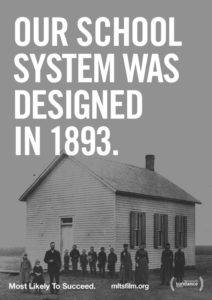Education system innovation requires more than rearranging the deck chairs on the Titanic
Before reading this post, please do 10 minutes or more on High Tech High.
I recently went to a screening of Most Likely to Succeed. The documentary isn’t available for purchase yet, but it is being screened in communities across the country.
Complete reviews of the film are available all over the interwebs, so I will spare the reader my take on the plot and narrative of the film. However, I will say that I agreed with nearly all of it. The message of the film is that our current education system is outdated. Although it was highly innovative for its time, the system was not created for an era in which virtually every student has access to the world’s facts in his or her pocket. A system where the most common question is, “When will I ever need to know this?” and the answer usually has something to do with getting into college or a likely future need to self-install carpeting into a round room.
Two years ago, I was involved in the creation of a charter school in Colorado. I sat on the board until the school was created, but I chose not to be a part of the board after the school was approved. Our vision was to create a school that could truly achieve individualized learning. They type of school where an autistic student with little emotional comprehension could work with his or her hands or mind to master his or her talents or interests or an artist could learn important principles of math, science, or history through customized art projects.
We were encouraged by the Colorado State Board of Education to innovate – as long as the end result looked like what was happening in the traditional schools. We could call it individualized learning as long as every student learned about bats in the 3rd grade and knew how to label a map of Europe in the 5th grade. The new school would also have to have licensed teachers overseeing the material taught by industry professionals to ensure that the material taught met academic standards – no matter how relevant to the content may be to the real world. If a student were to travel to Italy during the year they were supposed to be studying South America, the visit could not count towards any academic credit. If the student were to visit Italy the year Europe was taught, the visit would count – as long as the student brought back signed brochures and photos from each site they visited.
Any textbooks had to be approved, any industry professional had to be screened by the board or administrators approved by the board, but any teacher could teach any topic as long as they had a Colorado teaching license.
The school that was envisioned to offer individualized learning to all students gradually became molded into an alternative school where higher test scores were ensured and students who needed individualized learning would be encouraged to go through a special needs track in a traditional school.
Back to the movie and the screening. The film was full of examples of how the existing system was outdated and ineffective. The film had just as many examples of successful innovation. It was the kind of movie that made you wonder what would happen if they showed it to a room full of public school teachers. Would they be blown away by the inspiring message? Would they go back to their classrooms to lead a revolution of change?
I watched the film in a public high school auditorium where the audience was comprised of, you guessed it, public school teachers. As study after study was cited, misconception after misconception was documented, I felt that the following Q&A would be full of newly impassioned visionaries, ready to begin the revolt. Instead, the event hosts discussed how the school district was going to implement the concepts from the film by implementing some of the nomenclature and hosting discussions about how to create the illusion (my words) of innovation while not changing any of the standard practices.
The hosts made comments to the effect of, we can’t change the curriculum or the testing requirements, but we can have students do more collaborative work in groups. This was in response to the scenarios depicted in the film where classes were given projects with very few instructions and they were expected to learn and create through experimentation and failure.
When I got home from the film, I did some basic Googling and discovered that film screenings are being sponsored by public school districts all over the United States. Why would public school districts take ownership of a movie with a message that declares that the existing system mandated by those districts and state education boards is obsolete? Perhaps it’s to create the illusion of support. This movie is almost impossible to get access to unless it is presented in such screenings.
I recommend taking any opportunity to see the film. I also suggest participating in the panel discussions after the film. Ask the same questions presented in the film with the same boldness that they are presented in the film. This film brings so many great insights and truths to the surface, those who control the system shouldn’t control the conversation.

